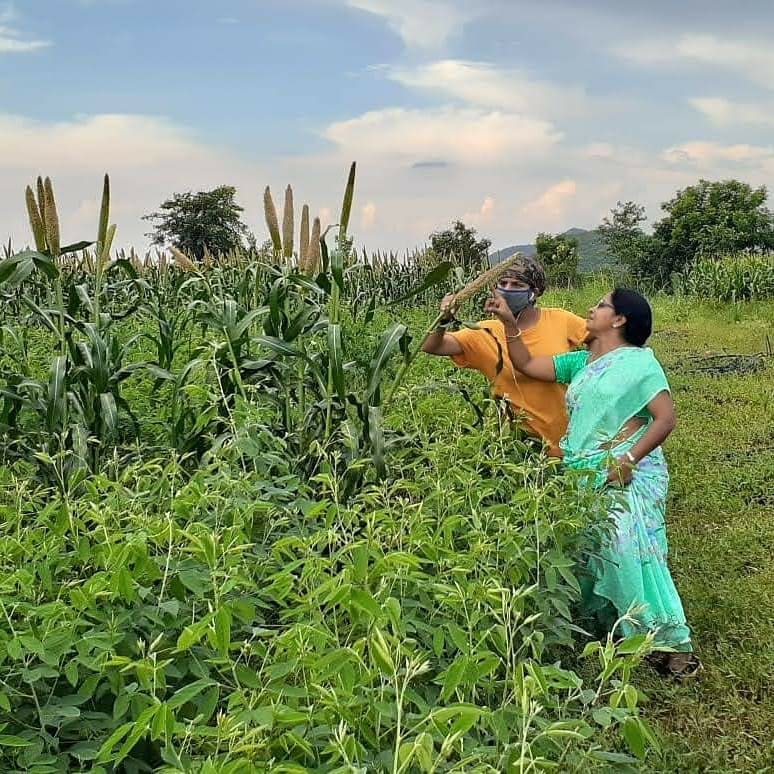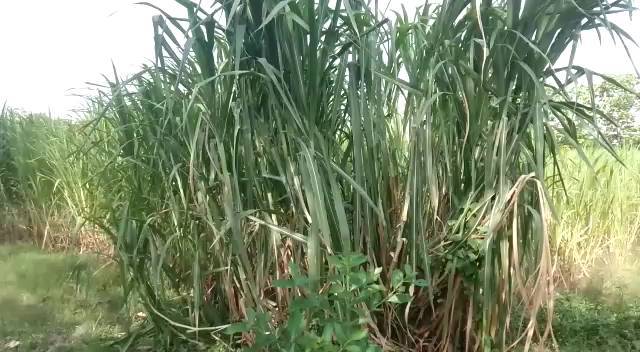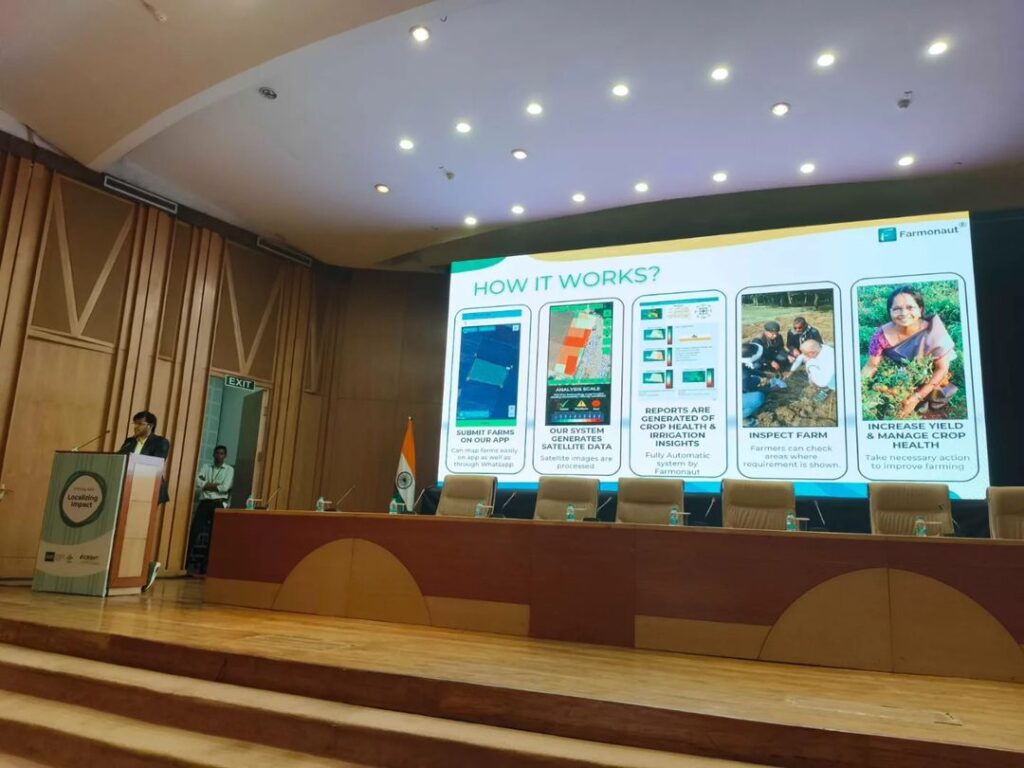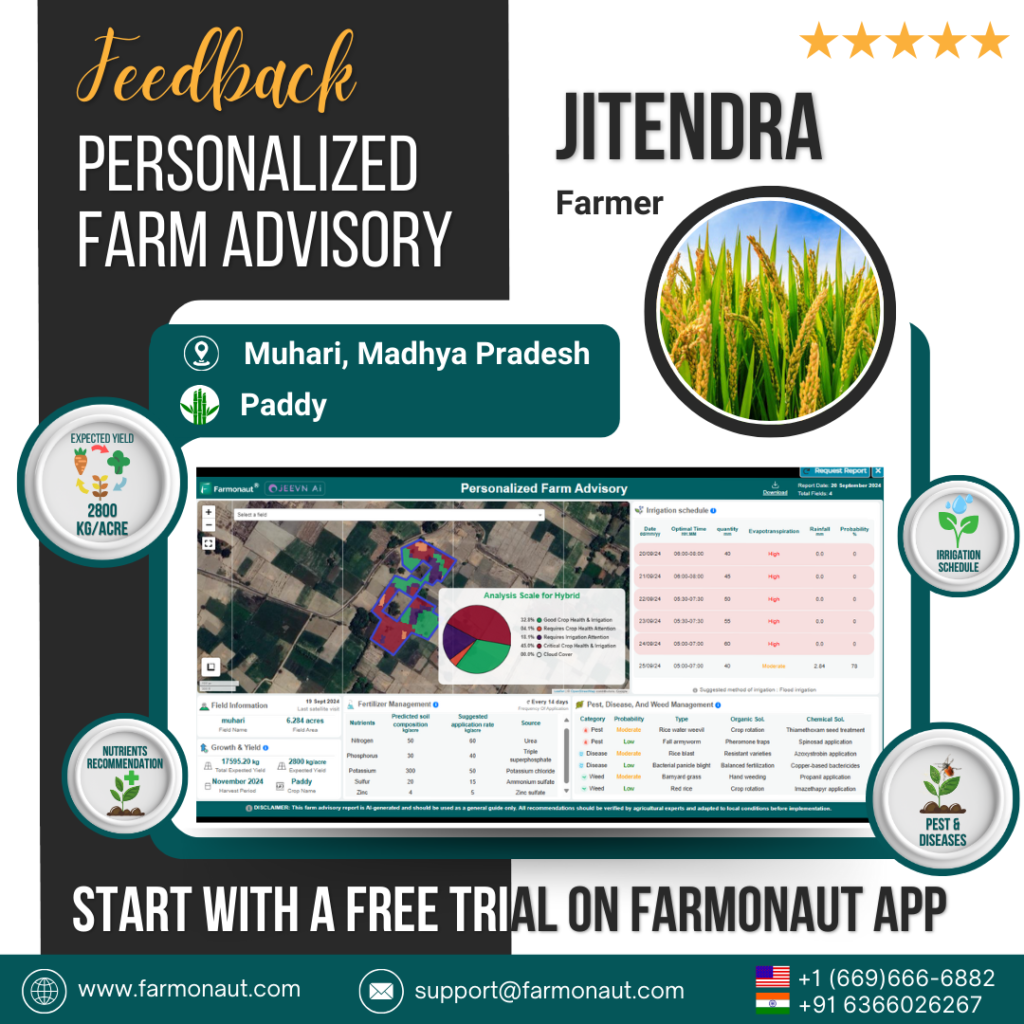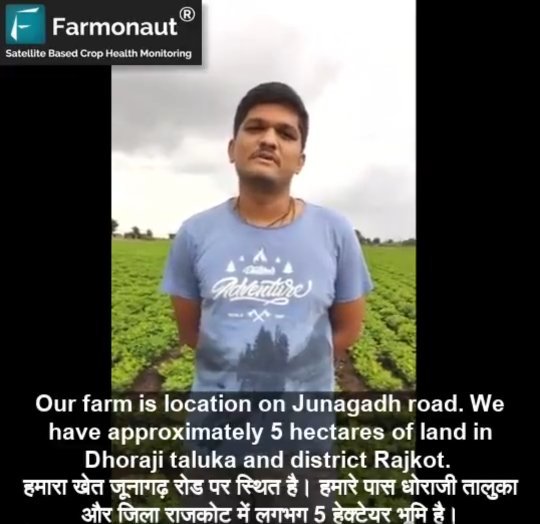Revolutionizing Agriculture: Farmonaut and Godrej Agrovet’s Groundbreaking Collaboration

In a landmark move that promises to reshape the landscape of Indian agriculture, we are thrilled to announce a significant collaboration between Farmonaut and Godrej Agrovet. This partnership marks a pivotal moment in our mission to revolutionize farming practices through cutting-edge technology and data-driven insights.
The Scope of the Collaboration
At the heart of this collaboration lies an ambitious project: mapping over 1,00,000+ acre farmer fields using Farmonaut’s advanced ecosystem of platforms. This monumental undertaking will not only capture crucial farmer and farm-level data but also pave the way for comprehensive monitoring through our state-of-the-art Satellite Based Crop Health Monitoring System.
The Power of Satellite-Based Monitoring
Our collaboration with Godrej Agrovet goes beyond mere data collection. In the coming days, these mapped fields will be subject to intensive monitoring, leveraging Farmonaut’s advanced satellite technology. This monitoring will encompass various critical aspects of agricultural management:
- Crop health assessment
- Water stress analysis
- Evapotranspiration monitoring
- Soil organic carbon measurement
- Precise weather forecasting
Why This Collaboration Matters
This partnership between Farmonaut and Godrej Agrovet represents a significant step forward in the realm of precision agriculture. By combining Farmonaut’s technological prowess with Godrej Agrovet’s extensive reach and agricultural expertise, we are setting the stage for a new era of smart farming in India.
Benefits for Farmers
The primary beneficiaries of this collaboration will be the farmers themselves. With access to real-time data and insights about their fields, farmers can:
- Make more informed decisions about crop management
- Optimize resource usage, including water and fertilizers
- Predict and mitigate potential issues before they escalate
- Increase overall crop yield and quality
- Reduce operational costs through efficient resource management
Environmental Impact
Beyond the immediate benefits to farmers, this collaboration has significant environmental implications:
- Reduced water waste through precision irrigation
- Minimized use of chemical fertilizers and pesticides
- Lower carbon footprint in agricultural operations
- Promotion of sustainable farming practices
Farmonaut’s Technological Edge
At the core of this groundbreaking project is Farmonaut’s advanced technological suite. Let’s delve deeper into the key components that make our satellite-based monitoring system a game-changer in agricultural technology.
Satellite-Based Crop Health Monitoring
Our satellite-based crop health monitoring system is at the forefront of precision agriculture. By utilizing high-resolution multispectral satellite imagery, we can provide farmers with unparalleled insights into their fields’ health and productivity.
Key Features:
- Real-time vegetation health index (NDVI) monitoring
- Early detection of crop stress and diseases
- Identification of nutrient deficiencies
- Crop growth stage analysis
Soil Organic Carbon Assessment
Understanding soil health is crucial for sustainable agriculture. Our system provides accurate measurements of soil organic carbon, a key indicator of soil fertility and health.
Benefits:
- Improved soil management strategies
- Enhanced carbon sequestration potential
- Optimized fertilizer application
Advanced Weather Forecasting
Our cutting-edge weather forecasting capabilities offer farmers hyper-local, accurate predictions, enabling them to plan their agricultural activities with precision.
Features:
- Short-term and long-term weather predictions
- Rainfall forecasts
- Temperature and humidity projections
- Extreme weather event warnings
Farmonaut vs. Traditional Monitoring Methods
To truly appreciate the revolutionary nature of Farmonaut’s satellite-based monitoring system, it’s important to compare it with traditional methods like drone and IoT-based farm monitoring.
| Feature | Farmonaut Satellite System | Drone-based Monitoring | IoT-based Monitoring |
|---|---|---|---|
| Coverage Area | Unlimited | Limited by flight time and regulations | Limited by sensor placement |
| Frequency of Data Collection | Daily to weekly | As per flight schedule | Continuous but localized |
| Initial Setup Cost | Low | High (drone purchase, training) | High (sensors, network setup) |
| Maintenance | Minimal | Regular (drone maintenance, battery replacement) | Regular (sensor calibration, battery replacement) |
| Weather Dependency | Low (can penetrate clouds) | High (affected by wind, rain) | Moderate (some sensors weather-sensitive) |
| Data Processing | Automated, AI-driven | Manual or semi-automated | Automated but requires integration |
| Scalability | Highly scalable | Limited by operational capacity | Scalable but costly |
The Road Ahead
As we embark on this exciting journey with Godrej Agrovet, we at Farmonaut are committed to pushing the boundaries of what’s possible in agricultural technology. Our vision extends beyond this initial project, aiming to create a sustainable, tech-driven agricultural ecosystem that benefits farmers, consumers, and the environment alike.
Future Developments
Looking ahead, we are working on several exciting developments:
- Integration of AI and machine learning for predictive crop modeling
- Expansion of our blockchain-based traceability solutions
- Development of mobile applications for easy access to farm data
- Collaboration with research institutions to refine our algorithms
Join the Agricultural Revolution
We invite farmers, agribusinesses, and agricultural enthusiasts to join us in this revolutionary journey. Here’s how you can get involved:
- Download our mobile app:
- Explore our web application for comprehensive farm management
- Developers can integrate our services using our API
- Check out our API documentation for detailed information
Subscribe to Farmonaut
Ready to transform your farming practices? Subscribe to Farmonaut and unlock the power of satellite-based agricultural insights:
Conclusion
The collaboration between Farmonaut and Godrej Agrovet marks a significant milestone in the journey towards smarter, more sustainable agriculture. By leveraging cutting-edge satellite technology and data analytics, we are not just monitoring farms; we are paving the way for a more productive, efficient, and environmentally friendly future of farming.
As we move forward with mapping and monitoring these 15,000+ farmer fields, we are filled with excitement about the positive impact this will have on individual farmers, the agricultural sector as a whole, and our shared environment. This is more than just a technological advancement; it’s a step towards ensuring food security, improving farmer livelihoods, and fostering sustainable agricultural practices.
We invite you to join us on this exciting journey. Whether you’re a farmer looking to optimize your operations, an agribusiness seeking to enhance your supply chain, or simply someone passionate about the future of agriculture, there’s a place for you in this revolution.
Together, let’s cultivate a smarter, more sustainable future for agriculture. Happy Farming!
FAQs
Q: What is satellite-based crop health monitoring?
A: Satellite-based crop health monitoring uses high-resolution satellite imagery to assess various aspects of crop health, including vegetation indices, water stress, and nutrient levels. This technology allows farmers to monitor large areas of land efficiently and make data-driven decisions about crop management.
Q: How does Farmonaut’s technology differ from traditional farming methods?
A: Farmonaut’s technology offers real-time, data-driven insights that traditional farming methods can’t provide. It allows for precise monitoring of large areas without the need for physical field visits, enabling early detection of issues and more efficient resource management.
Q: Can small-scale farmers benefit from this technology?
A: Absolutely! Farmonaut’s solutions are designed to be accessible and affordable for farmers of all scales. Small-scale farmers can particularly benefit from the precise insights that help optimize resource use and improve crop yields.
Q: How accurate is the weather forecasting provided by Farmonaut?
A: Farmonaut uses advanced meteorological models and satellite data to provide highly accurate, localized weather forecasts. While no forecast is 100% accurate, our predictions are consistently reliable and updated regularly to ensure farmers have the most current information.
Q: What is soil organic carbon, and why is it important?
A: Soil organic carbon refers to the carbon component of organic materials in soil. It’s crucial for soil health, water retention, and overall fertility. Monitoring soil organic carbon helps farmers maintain soil quality and implement sustainable farming practices.
Q: How often is satellite data updated?
A: The frequency of satellite data updates can vary depending on the specific service and satellite used. Typically, we provide updates every 3-5 days, but some services offer daily updates. Check our subscription plans for detailed information on data frequency.
Q: Is Farmonaut’s technology applicable to all types of crops?
A: Yes, our technology is versatile and can be applied to a wide range of crops, from grains and pulses to fruits and vegetables. The satellite-based monitoring system is adaptable to various agricultural contexts and crop types.
Q: How can I get started with Farmonaut?
A: Getting started is easy! You can download our mobile app, explore our web application, or contact our support team for personalized assistance. We offer various subscription plans to suit different needs and farm sizes.
Q: Is my farm data secure with Farmonaut?
A: Absolutely. We take data security very seriously. All farm data is encrypted and stored securely, adhering to the highest standards of data protection. We never share individual farm data without explicit consent.
Q: Can Farmonaut’s technology help in reducing the environmental impact of farming?
A: Yes, definitely. By providing precise data on crop needs, our technology helps optimize the use of water, fertilizers, and pesticides. This not only reduces costs for farmers but also minimizes the environmental impact of agricultural activities




